Unsure about your French table manners? Click Here to download > > How to avoid these 10 food etiquette mistakes !
- Home ›
- Destinations ›
- France Less Visited ›
- Castles Near Paris
3 Fascinating Castles Near Paris That Are Way Under The Radar
Published 18 May 2024 by Leyla Alyanak — Parisian by birth, Lyonnaise by adoption, historian by passion
Who doesn’t love a good castle? There are plenty near Paris - from the inevitable Versailles and Fontainebleau to the equally beloved Chantilly, Vincennes or Vaux-le-Vicomte. Recently I visited three historic under-the-radar châteaux that are easy day trips from Paris: Chateaudun, Anet and Maintenon. Here’s what I found.
Forget the long lines and selfie sticks and bus tours at France’s most famous castles. With 45,000 French châteaux waiting to be explored, you can easily step into history without having to battle crowds.
The three I’m about to describe share fascinating histories and stunning architecture. They’re within day trip distance of Paris, but they’re off the beaten path, and you’ll be able to experience them in relative tranquility. I plan to surprise you.
NOTE: Pages on this site may contain affiliate links, which support this site. See full Privacy Policy here.
All three châteaux sit in the Eure-et-Loir department, in the “official” region known as Centre-Val-de-Loire, roughly equivalent to the eastern Loire Valley, southwest of Paris.
And all three can easily be reached from Paris by car or train, making for one or several wonderful day trips.
A GEOGRAPHICAL NOTE
The Eure-et-Loir department has no “e” in Loir, whereas the region, Centre-Val-de-Loire, does. So does the famous Loire River, so filled with castles. The larger river in this case is the Loire, and a smaller tributary is the Loir. Confusing? It gets even more interesting!
If I’ve chosen these three, it’s not only because they are within easy reach of Paris or are beautiful or culturally important, but also because each was owned by a fascinating historical character.
Chateaudun
When you drive from Paris towards the Loire Valley, Chateaudun is the first castle along your route and is often called “the first Loire château”.
It’s also the first historically, dating back to the 12th century. Despite many expansions and renovations over four centuries, Chateaudun retains a fortress-like aspect, especially if seen from the “back”.
So yes, it’s mostly medieval, with quite a bit of Gothic, and acts as a bridge to the Renaissance with its grand staircase, known as the “Escalier d’honneur”, considered one of the first examples of Italianate influence in France: it’s open, ornate and less utilitarian than staircases usually were back then.
While I wasn’t able to climb to the top, I did get to admire it both from within and from the outside.
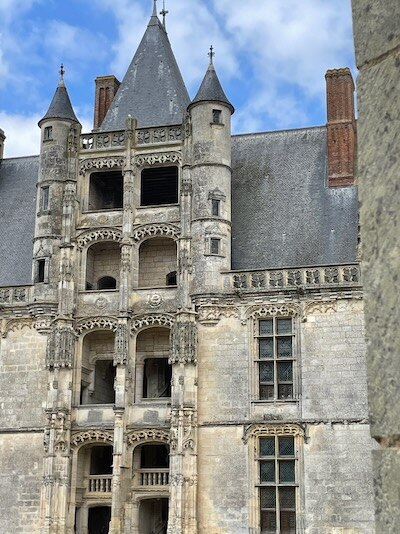 |
 |
If you’ve been following the history of Joan of Arc, you might remember the name Jean de Dunois, her companion-in-arms. He was the illegitimate son of the king’s (Charles VI) younger brother Louis I, Duke of Orleans, providing the château with a strong royal connection.
Dunois, a brilliant military leader, was famously known as the “bastard of Orleans”, a word with no derogatory connotations, at least not in those days.
We’re in the heart of the Hundred Years’ War, during which the English win the battle of Agincourt. Jean’s brothers are either captured or killed, and Jean becomes head of his family, distinguishing himself in battle. In 1428 the city of Orleans is under English siege and Jean is leading the French in their resistance. When Joan of Arc arrives with her army, Joan and Jean together free the city, and he becomes a follower, joining her on her campaigns. Eventually, he becomes one of the kingdom’s top officials.
Chateaudun castle was a gift from the king, but it was an austere fortress which Dunois decided to embellish. Of the original, only the dungeon remains.
In his renovations, Dunois built a chapel to hold a holy relic of the cross. This made it one of the few holy chapels – Sainte-Chapelle – in France, but the relic, along with most of the chapel’s furnishings, perished during the French Revolution. Other than a set of 15 statues and a fresco, the chapel today stands empty.
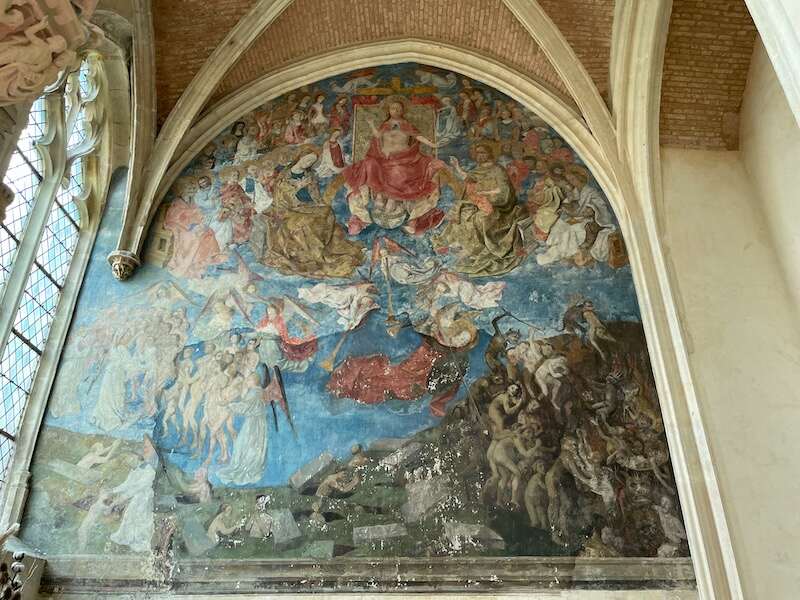
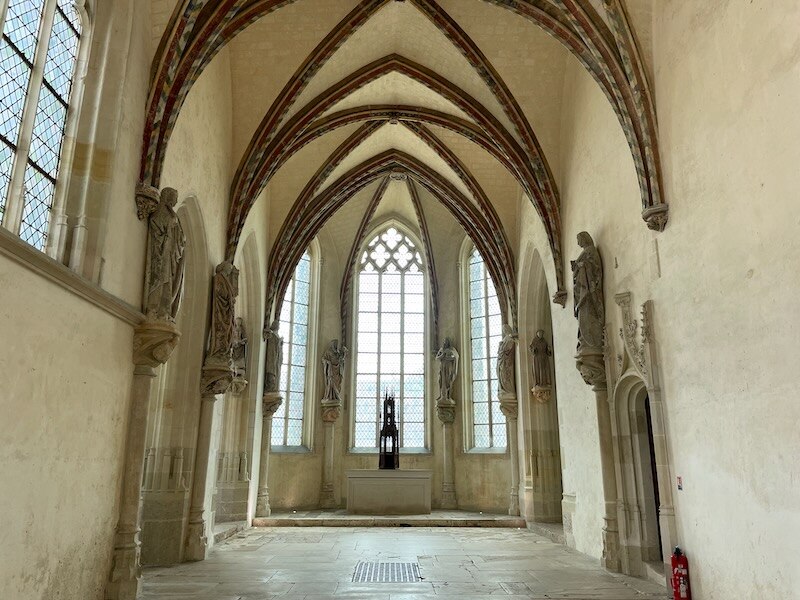 Chateaudun Chapel once held a holy relic, but the French Revolution destroyed the interior, leaving only statues and a fresco. ©OffbeatFrance/Leyla Alyanak
Chateaudun Chapel once held a holy relic, but the French Revolution destroyed the interior, leaving only statues and a fresco. ©OffbeatFrance/Leyla AlyanakArchitecturally speaking, the outstanding features of Chateaudun are its dungeon, the chapel and the staircase. I was also attracted by the radically different styles of the front and the back (a feeling I also experienced at the Château d’Amboise) making it difficult to reconcile the two, at least at first.
During his lifetime, Jean de Dunois was undoubtedly more famous than Joan of Arc: a renowned soldier and diplomat, and a relative of the king. Yet today, we know him almost exclusively as part of Joan of Arc’s army. A twist of fate.

How to visit
- There’s a direct train to Chateaudun from Paris, which makes things easier.
- You can drive via the A10 and A11, which takes about 2 hours.
- You can buy your tickets ahead of time here if it’s high season. Otherwise, just show up.
Château d’Anet
The Château d’Anet, unlike Chateaudun, was born of a single person’s desire: Diane de Poitiers, mistress of King Henri II. The king would visit often to hunt with the sporty Diane, which sat none too well with his wife, the indomitable (but distinctly less attractive) Catherine of Medici.
No matter – Catherine would get her revenge.
To design her château, Diane – a patron of the arts and lover of beautiful things – brought in none other than Philibert de l’Orme, the king’s favorite architect (who was also responsible for Fontainebleau). The result was architecturally splendid, the country’s first true French Renaissance château.
Built in 1548 over the remnants of two earlier castles, everything about it screams Renaissance, from the sculpted reliefs by Jean Goujon, to those classical proportions and symmetry, ornamental façades, pilasters and pediments, intricate carvings and sculptural niches. And it was all overseen (and paid for) by Diane.
Other than being a Renaissance showcase, what really draws us here are Diane and Henri, theirs being one of France’s most recognizable love stories.
A widow, she is named governess to a little prince; the prince (along with his brother) is exiled to Spain in exchange for his captive father; upon returning he meets Diane again; after a while they become lovers (she is 20 years his senior); he gives her Chenonceau Castle as a gift, intensifying Catherine’s ire.
So when a jousting wound kills Henri prematurely, Catherine wastes no time expelling Diane from Chenonceau, which she had long coveted, and Diane retires here, to the Château d’Anet. As they say in French, “Revenge is a dish best eaten cold.”
From the outside, the château is impressive, with moats (now grassed over), a spectacular entrance and plenty of Renaissance reminders.
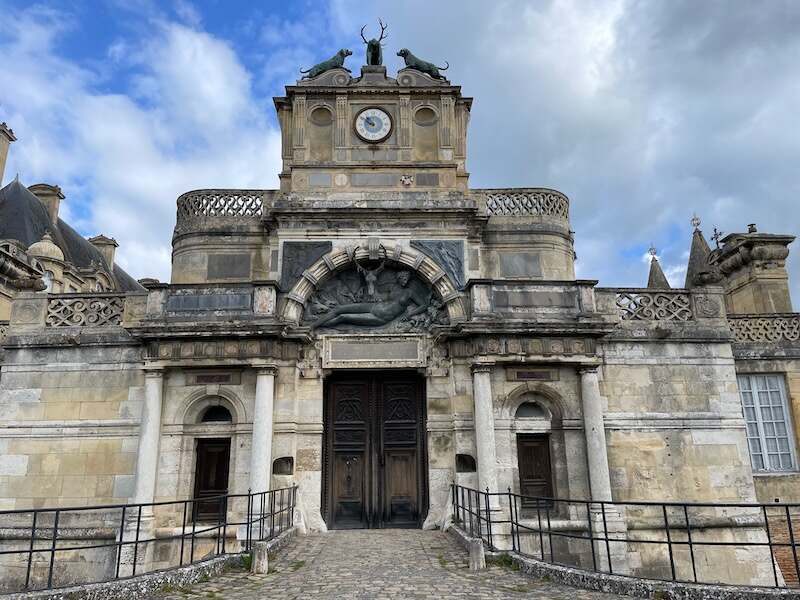
Only one wing remains of the structure built by Diane, but we know plenty about the original from recent archeological discoveries of a cryptocporticus, a Roman-style covered corridor, and several other foundations. Some of Diane’s original possessions, like her bed, are still here.
The Revolution was unkind to the château, as it would be to many national treasures. The gardens were destroyed, the wing used by Diane and Henri was razed, and most of the furnishings were scattered. A dozen stained glass windows that once graced the chapel now sit in the Chartres Musée des Beaux-Arts. Other items ended up in the Museum of National Monuments in Paris or in the Louvre.
The most visible remains of her presence are her monograms, the letter “D”, often intertwined with Henri’s H, and the many crescents scattered throughout the château’s decor (the moon was Diane’s emblem although she, strangely enough, was moonphobic).
 Diane’s monogram and moon symbol. ©OffbeatFrance/Leyla Alyanak
Diane’s monogram and moon symbol. ©OffbeatFrance/Leyla AlyanakTwo structures remain from Diane’s time that are the château’s “pièces de résistance”: the royal chapel, and Diane’s funeral chapel.
Philibert de l’Orme’s royal chapel is a decorative marvel, its Roman-style cupola reaching up to the sky like a whirlpool. An even greater stroke of genius is the marble floor below, designed to mirror the cupola’s intricacies.
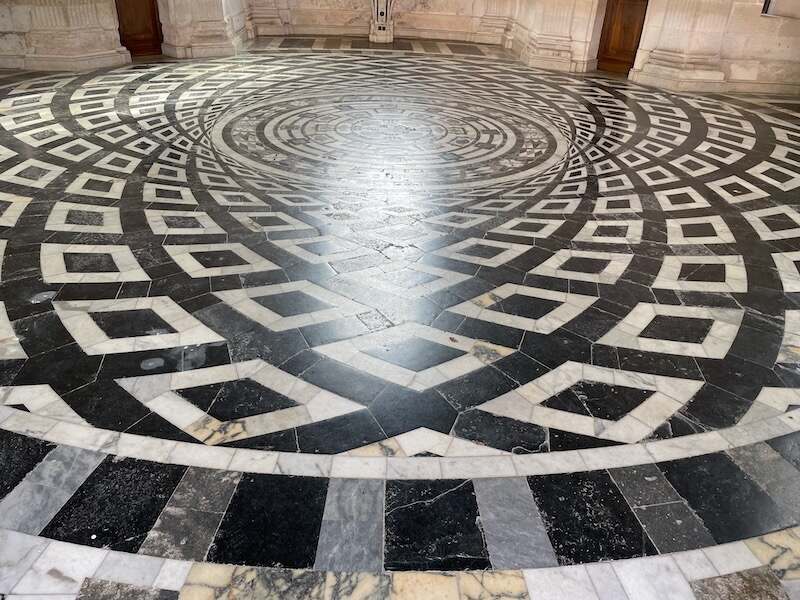 Floor of the Royal Chapel at Château d’Anet. ©OffbeatFrance/Leyla Alyanak
Floor of the Royal Chapel at Château d’Anet. ©OffbeatFrance/Leyla AlyanakAs for the funeral chapel, it was commissioned by Diane before her death and she was buried here. But she wouldn’t stay.
Revolutionary authorities opened the sarcophagus to retrieve the lead of which it was made – they needed bullets – and removed her body, which ended up in the local cemetery.
In 2008, surprise: a group of scientists visited the cemetery to analyze her remains. They discovered her body had 250 times more gold than average, which helped them identify her, since Diane was known for regularly ingesting gold. Identified positively, she was replaced in her sarcophagus in 2010, where she still lies today.
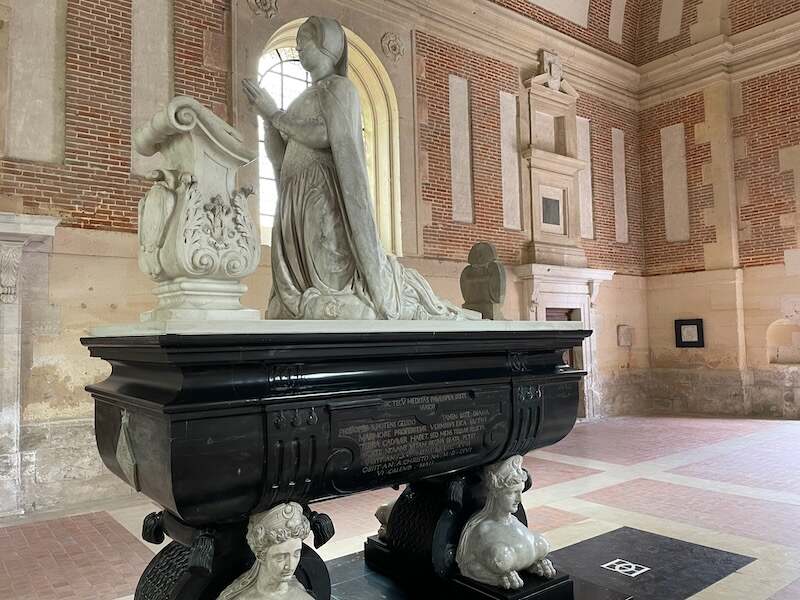 Diane de Poitiers funeral chapel and the sarcophagus in which her remains still lie today. ©OffbeatFrance/Leyla Alyanak
Diane de Poitiers funeral chapel and the sarcophagus in which her remains still lie today. ©OffbeatFrance/Leyla AlyanakDiane was a woman beyond her time: she was sporty, bathing daily in cold water, and a huntress, as befits her name; she was brilliant and erudite, and politically savvy. Her business sense allowed her to amass a fortune in properties during her lifetime, and her love affair with Henri II marked France. This is one woman history will not forget.
After Diane’s death, Anet would be handed around through relatives and some restoration efforts would be made – not with the happiest results. Her fountain would be displaced, the gardens redone, stained glass windows removed and the interior rearranged.
Today, it is owned privately and inhabited by the Yturbe family, who has opened parts of the château to visitors. And while most of Diane’s furniture and possessions have gone, efforts have been made to replace them with items from the same period so that you may well feel you’ve walked back into the 16th century for a while.
How to visit
- You can drive from Paris to Anet along the N12 (around 1h30m)
- You can take public transport but it’s complicated, as you have to first take a train to Mantes-la-Jolie (from Montparnasse station in Paris) and then switch to a bus, getting off at Boxhorn in Ézy-sur-Eure. The château is a 5-minute walk away. There are several connections a day but this would require some planning.
- The château can be visited most afternoons but you need to reserve, since you can only enter with a guide. Use this form to book a tour (€11 at the time of writing).
- Across the street from the château is the Renaissance Interpretation Center, with interactive exhibits and an in-depth look at Diana and her time at the château.
Château de Maintenon
While Diane semi-ruled over France from the bedroom, Madame de Maintenon did one better: she married a king!
It was a most unlikely outcome to her modest start in life.
Françoise d'Aubigné, her real name, was born in a debtor’s prison, where her father was serving time with his wife in tow. She would eventually marry a far older and chronically ill poet and playwright. Upon his death, she would become governess to King Louis XIV’s illegitimate children, brought in by the king’s then favorite mistress, Madame de Montespan.
When Montespan’s reign as king’s favorite ended, Madame de Maintenon began taking her place, eventually marrying the king in secret, as she was of “inferior” social rank. She would undoubtedly have influence over him, but her real political impact is unknown. Otherwise, she is most famous for having founded St. Cyr, a school for young ladies, which Napoleon eventually turned into France’s renowned military academy. She is buried there.
Along the way, the king helped her buy the Château de Maintenon and turn the former 13th-century fortress into the comfortable early Renaissance castle we know today.
The château itself is a delight to visit, with many reminders of its illustrious former owner – leather wall coverings, a Gothic chapel, a library displaying her book collection, or the “salon du roi”, the room occupied by Louis XIV when he visited.


The château exterior is every bit as compelling as its interior, with its mixture of styles but, most fascinating to me, is the unfinished aqueduct that sits at the bottom of the formal French gardens.
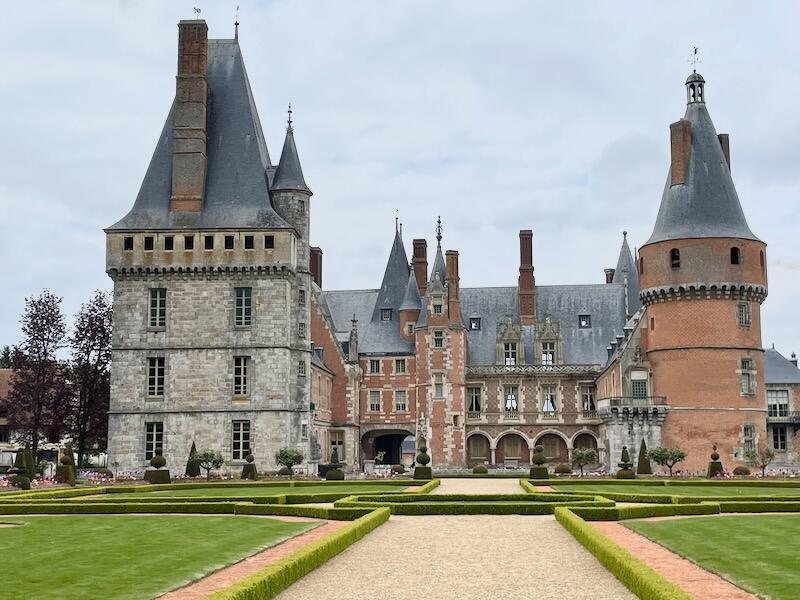

The aqueduct turned out to be a king’s folly.
Desperate to bring water to Versailles, Louis XIV thought he could divert the waters of the Eure river, some 80km/50mi away. His chief engineer, the fabulous Vauban, suggested an underground piping system, but Louis’s ego wanted his works to be seen: he opted for a soaring aqueduct, in parts higher than Notre-Dame in Paris.
But the project was abandoned before it was even finished. Many of the workers (10,000 would die building this aqueduct) were soldiers and when war broke out a few years later, they were sent to the front, depriving the site of manpower. Over the years, it would begin to crumble, its stones carted off to build palaces and walls elsewhere. Today, it’s not in great shape, and a local association is doing its best to protect it from further deterioration.
How to visit
- You can drive from Paris along the A10 (1h30m)
- You can catch a direct train from Paris (Montparnasse station) in well under an hour
- You don’t need an advance ticket and can buy it directly in the gift shop when you arrive.
- If you’re here at lunchtime, there’s a lovely little restaurant on the market square a couple of blocks from the château called “Aux Deux M”, with affordable authentic dishes. Make sure you reserve because it’s small.
Before you go…
Each of these châteaux represents women who lived in those times.
Chateaudun, a medieval fortress with plenty of Gothic (and an Italianate staircase) reflects the rise of Jean de Dunois, made historically famous through his support of Joan of Arc.
Anet, of course, was the Renaissance jewel of Diane de Poitiers, the place where her relationship with Henri II was allowed to flourish.
And finally, Maintenon features King Louis XIV’s ambition and Madame de Maintenon's extraordinary social rise.
And if you’re keen on castles, then head over to these other stories:
- 4 Chateaux Of Loire Valley And Their Conspiracy Theories, Lust And Secrets
- Chateau Bussy Rabutin And The Salacious Story Of The Count Who Lived There
- Voltaire In Love: The Improbable Power Couple Of The Chateau De Cirey

